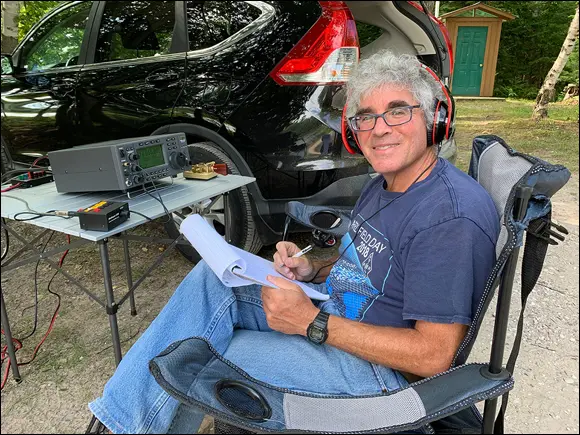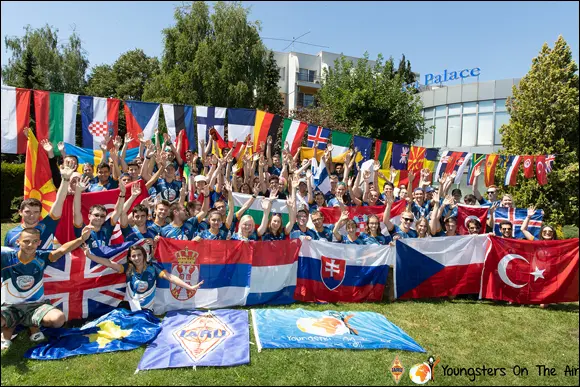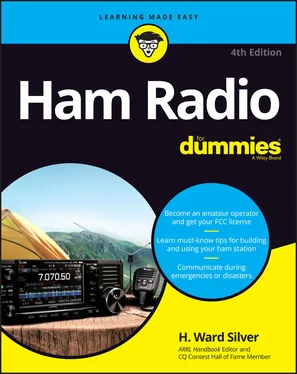One of the least visible of ARRL’s functions, but arguably one of its most important, is its advocacy of amateur radio service to governments and regulatory bodies. In this telecommunications-driven age, the radio spectrum is valuable territory, and many commercial services would like to get access to amateur frequencies, regardless of the long-term effects. ARRL helps regulators and legislators understand the special nature and needs of amateur radio.
ARRL benefits to the public
Although it naturally focuses on its members, ARRL takes its mission to promote amateur radio seriously. To that end, its website is largely open to the public, as are all bulletins broadcast by W1AW (see the preceding section). The organization also provides these services:
Facilitates emergency communications: In conjunction with the field organization, ARES teams around the country provide thousands of hours of public service every year. While individual amateurs render valuable aid in times of emergency, the organization of these efforts multiplies the usefulness of that aid. ARRL staff members also help coordinate disaster response across the country.
Publishes The ARRL Handbook for Radio Communications: First published in 1926, “The Handbook” is used by telecommunications professionals and amateurs alike. Information about the current edition is available at www.arrl.org/arrl-handbook-reference , including a link where you can get your own copy.
Provides technical references: The league publishes numerous technical references and guides, including conference proceedings and standards.
Promotes technical awareness and education: ARRL is involved with the Radio merit badge for scouting and with Jamboree-on-the-Air programs. It also sponsors the Teachers Institute on Wireless Technology to train and license primary and secondary educators.
Taking Part in Specialty Groups
Ham radio is big, wide, and deep. The hobby has many communities that fill the airwaves with diverse activities. A specialty club or organization focuses on one aspect of ham radio that emphasizes certain technologies or types of operation. Many specialty organizations have worldwide membership.
Some clubs focus on particular operating interests, such as qualifying for awards or operating on a single band. An example of the latter is the 10-10 International Club ( www.ten-ten.org ), which is for operators who prefer the 10 meter band — a favorite of low-power and mobile stations and one of the HF bands open to entry-level Technician class licensees. The 10-10 club sponsors several contests every year and offers a set of awards for contacting its members. A similar group, Parks On the Air (POTA: parksontheair.com) sponsors awards for operating from and for contacting stations operating in local and national parks, monuments, recreation areas, trails, and all sorts of fun spots. Some operate casually and some are quite active in their quest to activate or contact as many “counters” as possible.
To find specialty clubs, search your favorite search engine for your area of interest and the phrase radio club . Using the search term 10 meter amateur radio club, for example, turns up a bunch of ham clubs and forums about operating on the 10 meter band.
This section lists only a few examples of the specialized groups you’ll find in ham radio; there are many, many more.
On the Air — IOTA, SOTA, and POTA
With the recent introduction of superb quality low-power radios and portable antennas, operation from the field has really become popular. The Islands On the Air program (IOTA; www.iota-world.org ) encourages hams to operate from salt-water islands and the less-common rocks and reefs are highly sought after. The enthusiasm extends to dry land as hams clamber to the tops of mountains to put small stations on the air for Summits On the Air (SOTA; www.sota.org.uk ). For the 2016 centennial of the U.S. National Parks, the ARRL sponsored the National Parks On the Air award. The program proved so popular that activity evolved into the Parks On the Air (POTA) program I discussed earlier. What do all these programs have in common? That “OTA” or “On the Air,” which is what hams like doing best. Why not combine OTA with your favorite outdoor activity? (See Figure 3-3.)

FIGURE 3-3:Derek Cohn (WBØTUA) had a blast while activating his first Park On the Air — Beaver Island, Michigan.
Another “on the air” group, YOTA stands for Youngsters On the Air. (“Youngsters” means younger adults and youth in Europe, home of the organization.) The members of YOTA ( www.ham-yota.com ) are mostly between the ages of 15 and 25, including everyone from high school students through young adults already starting their careers. Founded in Europe, YOTA hosts numerous on-the-air events, such as YOTA Month with special -YOTA call signs, and sponsors the Youth Contesting Program (YCP) where young operators get to operate at world-class contest stations. YOTA also helps radio clubs host gatherings like in Figure 3-4 that are open to young hams from around Europe, Africa, and world-wide. YOTA-like groups are growing here in the Americas and in Asia with a camp planned for the summer of 2021 by Youth On the Air ( www.youthontheair.org ).
 If you have an interest in scouting, the annual national Jamboree also hosts a ham radio station and radio merit badge programs. Watch for Jamboree On the Air (JOTA:
If you have an interest in scouting, the annual national Jamboree also hosts a ham radio station and radio merit badge programs. Watch for Jamboree On the Air (JOTA: www.scouting.org/international/jota-joti/jota ) to learn how to contact the scouts during the event.
One type of specialty club is the contest club . Members enjoy participating in competitive on-the-air events known as contests or radiosport (see Chapter 11). These clubs challenge one another, sponsor awards and plaques, and generally encourage their members to build up their stations and techniques to become top contest operators.

FIGURE 3-4:These young hams from Europe, Africa, and Asia gathered in Bulgaria for YOTA Camp 2019.
Contest clubs compete locally, regionally, or nationally depending on the rules of the competition. You can view an extensive list of clubs that compete in the ARRL club competition at www.arrl.org/contest-club-list .
No less competitive than contest operators are the long-distance communications specialists, or DXers, who specialize in contacts with places well off the beaten track. The quest to work ’em all (contact every country on every ham band) lasts a lifetime, so DXers form clubs to share operating experiences and host traveling hams, fostering international communications and goodwill along the way.
 Many contesters are also DXers, and vice versa. Because of the international nature of DXing and contesting, clubs that specialize in these activities tend to have members sprinkled around the globe. You can find lists of these organizations at
Many contesters are also DXers, and vice versa. Because of the international nature of DXing and contesting, clubs that specialize in these activities tend to have members sprinkled around the globe. You can find lists of these organizations at www.dailydx.com/clubs.htm .
Читать дальше


 If you have an interest in scouting, the annual national Jamboree also hosts a ham radio station and radio merit badge programs. Watch for Jamboree On the Air (JOTA:
If you have an interest in scouting, the annual national Jamboree also hosts a ham radio station and radio merit badge programs. Watch for Jamboree On the Air (JOTA: 
 Many contesters are also DXers, and vice versa. Because of the international nature of DXing and contesting, clubs that specialize in these activities tend to have members sprinkled around the globe. You can find lists of these organizations at
Many contesters are also DXers, and vice versa. Because of the international nature of DXing and contesting, clubs that specialize in these activities tend to have members sprinkled around the globe. You can find lists of these organizations at 










